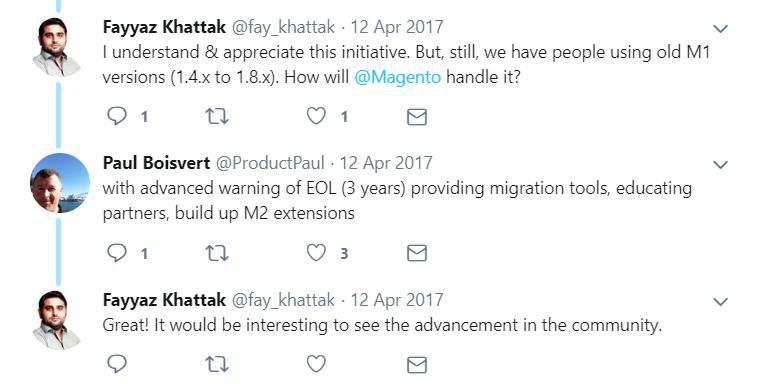
Decided to migrate from Magento 1 to Magento 2? This is a perfectly sound resolution, even despite the fact that Magento 1 version, both Community and Enterprise Editions, will continue to be supported till July 2020, which seems like quite a lot of time. Still, the migration process will be neither simple nor fast, so the earlier you embark on this process, the better.
Table of contents:
4 stages of migration from Magento 1 to Magento 2
How to migrate from Magento 1 to Magento 2: Step-by-step Guide
How to optimize your upgraded Magento 2
Here is a number of other arguments “for” migration from Magento 1 to Magento 2:
- There will be no more improvements and innovations in Magento 1 version, only support.
- You will gain access to plenty of solely Magento 2 extensions.
- You will be able to provide a better and smoother user experience to your customers.
4 stages of migration from Magento 1 to Magento 2
This global process of migration can be divided into four comprehensive stages:
- Theme Migration
- Extension Migration
- Customizations Migration
- Data Migration
Stage 1: Migrate theme
Unfortunately, you can’t carry out a direct migration of the theme compatible with version Magento 1 into the later version. Usually, theme developers timely upgrade their themes, making it no trouble to upload and install the proper version. But if the new version of the theme wasn’t released, perhaps it’s a sign you need to change the webstore design for something new. You may also create your own theme and make it user-responsive, but it’s wise to reserve to it only in case you are certain you will manage to do it with your own forces
Stage 2: Migrate extension
Extensions serve to provide new additional functionalities that the Magento platform lacks. Like with themes, version compatibility is the key issue here, for if the developer decides not to upgrade the extension to the new version, you will be unable to further use it.
Stage 3: Migrate customizations
Custom code from Magento 1 will be at large compatible with Magento 2. However, due to the structural difference in two platform versions, the migration will be associated with additional testing to ensure everything works.
Stage 4: Migrate data
The final stage is moving your data together with settings from one version to another. For this process, you can apply Magento 2 Data Migration Tool, which will perform the migration of various data types (products and orders, categories and store configurations) from Magento 1 to Magento 2.
How to migrate from Magento 1 to Magento 2: Step-by-step Guide
Step #1: Install via Composer Data Migration Tool
Make sure you install the version of the tool corresponding with the current version of Magento.
In case you don’t know your Magento version, go to the root directory and enter this command:
|
1 |
php bin/magento --version |
As you have determined your Magento version, you can install its correct version. You also need to update the location of the tool package in the composer.json file in the root directory. To accomplish that, run the command:
|
1 2 3 |
composer config repositories.magento composer https://repo.magento.com Composer require magento/data-migration-tool:<version> |
Specify in <version> your Data Migration Tool version.
Enter authentification keys. Navigate to Magento Marketplace -> Sign in -> Click on My Access Keys.
In case you already have keys, then public key is your username and the private one is password. If you don’t have keys, you will need to create them by clicking on Create a New Access Key button.
Step #2: Configure Data Migration Tool
As the installation is completed, in the following directories you will find mapping and configuration files for Data Migration Tool. Here you will find the scripts for migrating from Magento 1 Community Edition to Magento 2 Enterprise Edition.
|
1 |
<Magento 2 root dir>/vendor/magento/data-migration-tool/etc/ce-to-ee |
And this command is for migrating from Magento 1 Enterprise Edition to Magento 2 Enterprise Edition.
|
1 |
<Magento 2 root dir>/vendor/magento/data-migration-tool/etc/ee-to-ee |
Before any migration and configuration, you will have to create a config.xml file in the corresponding directory.
|
1 2 3 4 5 6 7 8 9 10 11 12 13 |
<source> <database host=“localhost” name=“Magento1-DB-name” user=“DB-username” password=“DB-password” /> </source> <destination> <database host=“localhost” name=”Magento2-DB-name” user=“DB-username” password=“DB-password” /> </destination> </options> |
Where:
<source> contains Magento 1 database info.
<destination> contains relevant Magento 2 data.
<crypt_key> is Magento 1 encryption key that you can find in <key> tag for <Magento 1 rootdir>/app/etc/local.xml file.
Step #3: Settings Migration
Data Migration Tool can also be used to migrate from Magento 1 to Magento 2 the settings that include payment, shipment, tax and other configurations. To perform migration of settings, go to Magento 2 root directory via SSH terminal and launch the following command:
|
1 |
php bin/magento migrate:settings --reset <path to your config.xml> |
Here, <path to your config.xml> is vendor/magento/data-migration-tool/etc/ce-to-ee/<Magento 1.x version>/config.xml.
As the settings migration is successfully completed, you will receive a message.
Step #4: Data Migration
To migrate the whole body of data like store items and their categories, customers, their orders and wishlists, etc., run this command:
|
1 |
php bin/magento migration:data --reset <path to your config.xml> |
How to optimize your upgraded Magento 2
Migration is a great opportunity to level up your Magento store. Here are the main optimization and improvement points:
- Extensions. Which extensions to migrate and which are better to be left behind in Magento 1? The best way to determine this is to ask yourself a question: “Which extensions do I use on a day-to-day basis?”. There is also a number of extensions that will certainly come of use at every Magento 2 webstore: Improved layered navigation, Elastic search, One step checkout, ERP integration, etc. Great role in the extension quality plays the developer himself, so it is also important to check his reputation and reliability.
- Payment system. There are two categories of them – a reliable but expensive one or a cheap but not particularly secure or functional. The choice is yours, though we adhere to the first type; remember – buy nice or buy twice.
- Go multistore. Magento 2 will provide store owners with a more functional multistore managements. But still, two or more stores will demand more commitment and a number of language, currency, tax, catalog, and many other settings, so this decision must be taken only after careful consideration.
- Hosting. If you were for a long time unsatisfied with your current hosting, migration is the right time to consider doing something with it. One solution is to upgrade the one you have to a Premium, for example, as it will undoubtedly provide you with wider functionality. Another way is to change hosting completely for another one, and in this case I would advise a Magento specialized Nexcess hosting. Its main advantages are 24/7 support, scalability and fast speed.
- Outsourcing. To manage a larger load of work, you may consider hiring a third-party team. In this case, you will need to select a good reliable tracking tool, and the choice here is rather wide: JIRA, Asana, Trello, Slack, Redmine and many others.
As you have performed the migration from Magento 1 to Magento 2, ensure the system is functioning properly. If you are cautious that you won’t be able to perform the migration with your own hands, turn to BelVG professional team.






Thank a lot for this article!
Thanks for the great article!